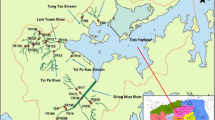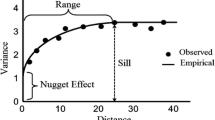Abstract
This paper proposes a quantitative method to optimize the existing river monitoring network based on a modified approaching degree model, T test, and Euclidean distance. In this study, the Liaohe River located in Liaoning province, China, was taken as a research object. Samples were collected from 8 sampling sites throughout the monitoring network, and water quality parameters were analyzed every 2 months from January 2009 to December 2010. The results show that the average concentrations of the ammonia nitrogen (NH4+-N) and chemical oxygen demand (COD) were beyond grade III of the Environmental Quality Standards for Surface Water of China (GB3838-2002), and they were the main water quality parameters. After optimization, the number of monitoring sections along the Liaohe River was reduced to five from the original eight, thus saving 37.5% of the monitoring cost; meanwhile, there is no significant difference between the un-optimized and optimized monitoring networks, and the optimized monitoring network remains to be able to perform as good as the original one. In addition, the total data attainment rate was improved greatly, and the duplicate setting degree of monitoring points decreased significantly compared with other optimal methods. The optimized monitoring network proves to be more efficient, reasonable, and economically feasible, so this quantitative method can help optimize the changing orderly river monitoring networks.

Similar content being viewed by others
References
Ahmed MK, Baki MA, Islam MS, Kundu GK, Habibullah-Al-Mamun M, Sarkar SK, Hossain MM (2015) Human health risk assessment of heavy metals in tropical fish and shellfish collected from the river Buriganga, Bangladesh. Environ Sci Pollut Res 22:15880–15890
Akkoyunlu A, Akiner ME (2012) Pollution evaluation in streams using water quality indices: a case study from Turkey’s Sapanca Lake Basin. Ecol Indic 18:501e511. https://doi.org/10.1016/j.ecolind.2011.12.018
Antanasijević D, Pocajt V, Povrenović D, Perić-Grujić A, Ristić M (2013) Modelling of dissolved oxygen content using artificial neural networks: Danube River, North Serbia, case study. Environ Sci Pollut Res 20(12):9006–9013. https://doi.org/10.1007/s11356-013-1876-6
Bai L (2013) Layout optimization of surface water environmental monitoring cross sections of Min River catchment. Environ Sci Surv 32(6):105–108 (in Chinese)
Beckers CV, Chamberlain SG (1974) Design of cost-effective water quality surveillance systems, U.S. EPA-600\5–74-404, Washington D.C., U.S.A
Benouara N, Laraba A, Rachedi LH (2016) Assessment of groundwater quality in the Seraidi region (north-east of Algeria) using NSF-WQI. Water Sci Technol Water Supply 16(4):1132e1137. https://doi.org/10.2166/ws.2016.030
Bonde GJ (1977) Bacterial indication of water pollution advances in aquatic microbiology. In: Droop MR, Januasch HW (eds) . Academic Press, London and New York, pp 273–364
Boyer JN, Sterling P, Jones RD (2000) Maximizing information from a water quality monitoring network through visualization techniques. Estuar Coast Shelf Sci 50:39–48
Bu J, Chen H, Xu Y et al (2014) Ecological risk of interstitial water heavy metals and toxicity characterization of surface sediments in branches of Liaohe River. Asian J Ecotoxicol 9(1):24–34
Chen J, Song ZL, Zhao XL, Dai CX (2009) Optimized layout of water quality monitoring points in Xi River. Environ Sci Technol 32(7):107–108,112
Chen K, Ni MJ, Cai MG, Wang J, Huang D, Chen H, Wang X, Liu M (2016) Optimization of a coastal environmental monitoring network based on the kriging method: a case study of Quanzhou Bay, China. Biomed Res Int 2016:7137310–7137312. https://doi.org/10.1155/2016/7137310
Dong C (2004) Optimization of river water quality monitoring network in Shandong province [M.Sc. Thesis]. Shandong University, China
GB3838-2002 (2002) Environmental quality standards for surface water. Beijing: China State Environmental Protection Administration
Guo XQ (2005) Optimized selection in water quality monitoring of river inside the city by similarity method. Bull Sci Technol 21(3):360–363
Han F, Ma XP, Liu YY (2009) Pollution level and source apportionment of polycyclic aromatic hydrocarbons (PAHs) in Liaohe River. J Meteorol Environ 25(6):69–71
Harmancioglu NB, Alpaslan MN (1992) Water quality monitoring network design. J Am Water Resour Assoc 28:179–192
Lettenmaier DP (1978) Design considerations for ambient stream quality monitoring. Water Resour Bull 14(4):884–902
Li X, Liu L, Cao Y (2017) Optimization design of surface water environment monitoring sections of Malu River. Guangzhou Chem Ind 45(15):163–165
Li Y, Li KQ, Wang XL, Liang SK, Li YB, Dai AQ, Lu S, Zhang LJ (2015) Method of construction of a water quality monitoring system for total load control management of pollutants in coastal area: acasestudyin LaizhouBay. Period OceanUniv China 45(11):69–74 (in Chinese)
Liu Q, Liang L, Wang FY, Liu F, Wang YY (2013) Assessment of heavy metals pollution in sediments at riparian zone along the Liaohe river. Liaoning Agric Sci 4:1–6
Lu Y, Xie F, Tan H, Xu XJ, He JL (2007) Evaluation on the degree of pollution by heavy metals in soils with fuzzy approaching degree evaluation method. Environ Monit China 23(6):69–72
Memet V (2013) Dissolved heavy metal concentrations of the Kralk, Dicle and Batman dam reservoirs in the Tigris River basin, Turkey. Chemosphere 93:954
Mishra A (2010) Assessment of water quality using principal component analysis: a case study of the River Ganges. J Water Chem Technol 32(4):227–234
Moore SF (1973) Estimation theory applications to design of water quality monitoring system. J Hydraul Div – ASCE 99(5):815–831
Ning SK, Chang NB (2004) Optimal expansion of water quality monitoring network by fuzzy optimization approach. Environ Monit Assess 91:145–170
Noori R, Berndtsson R, Hosseinzadeh M, Adamowski JF, Abyaneh MR (2019) A critical review on the application of the national sanitation foundation water quality index. Environ Pollut 244:575e587. https://doi.org/10.1016/j.envpol.2018.10.076
Ramteke PW, Pathak SP, Bhattacherjee JW, Gopal K, Mathur N (1994) Evaluation of the presence–absence (P–A) test. A simplified bacteriological test for detecting coliform in rural drinking water of India. Environ Monit Assess 33:53–59
Strobl RO, Robillard PD (2008) Network design for water quality monitoring of surface fresh waters: a review. J Environ Manag 87:639–648
Strobl RO, Robillard PD, Shannon RD, Day RL, McDonnell AJ (2006) A water quality monitoring network design methodology for the selection of critical sampling points: part I. Environ Monit Assess 112(1–3):137–158
Tanos P, Kovács J, Kovács S, Anda A, Hatvani IG (2015) Optimization of the monitoring network on the River Tisza (Central Europe, Hungary) using combined cluster and discriminant analysis, taking seasonality into account. Environ Monit Assess 187(9):1–14. https://doi.org/10.1007/s10661-015-4777-y
Telci IT, Nam K, Guan JB, Aral MM (2009) Optimal water quality monitoring network design for river systems. J Environ Manag 90:2987–2998
Wang J, Sun SQ, Shao C, Sun EB (2012) Fuzzy cluster analysis in the optimization of water quality monitoring sections. Guangzhou Chemical Industry 40(7):153–154, 160 (in Chinese)
Wang H, Liu Z, Sun LN, Luo Q (2015) Optimal design of river monitoring network in Taizihe River by matter element analysis. PLoS One 10(5). https://doi.org/10.1371/journal.pone.0127535
Wang H, Liu CY, Rong LG, Wang XX, Sun LN, Luo Q, Wu H (2019) Optimal river monitoring network using optimal partition analysis: a case study of Hun River, Northeast China. Environ Technol 40(11):1359–1365
Ward RC (1979) Regulatory water quality monitoring: a systems perspective. Water Resour Bull 15(2):369–380
Ward RC (1996) Water quality monitoring: where’s the beef? Water Resour Bull 32(4):673–680
Xiao ZX (2008) The study on the optimization design of surface water environment monitoring sites of Huaihe River in Anhui Province [M.Sc. Thesis]. Hefei University of Technology, China
Xu YX, Zheng BH, Liu Y, Qin YW, Luo YP, Liao YH (2012) Application of the similarity method to optimize water quality monitoring sections of the Xiangjiang River mainstream. Water Resourc Protect 28(6):46–48 54. (in Chinese)
Yang C, Guo C, Yu Y (2018) Application of similarity method in the optimization of water quality monitoring sections of Songhua River mainstream in Jilin Province. Environ Sci Manag 43(6):112–116 (in Chinese)
Zadeh LA (2005) Fuzzy sets and fuzzy information: granulation theory. Beijing Normal University Press, Beijing
Zhang J, Wang SQ, Wang XF, Chen JP (2008) Distribution and pollution character of heavy metals in the surface sediments of Liaohe River. Environ Sci 29(9):2413–2418
Zhang MY, Zhang Y, Qian YY (2004) Optimization of environmental monitoring sites by optimal index method. J Saf Environ 4(2):66–67
Zhang WG, Guan XJ, Xu QS (2006) Water environment quality evaluation based on fuzzy nearness method. Water Resour Protect 22(2):19–22
Zhao ZM, Sun LN, Chen S, Wang H (2014) Application of the approaching degree method at riparian zone health assessment in Tieling section of Liao River. Chin J Ecol 33(3):735–740
Acknowledgments
The authors thank the staff of Shenyang University Laboratory of Eco-Remediation and Resource Reuse for their support during the field sampling, logistics, and laboratory analyses.
Funding
This study is financially supported by the China Major Science and Technology Program for Water Pollution Control and Treatment (2018ZX07601-002).
Author information
Authors and Affiliations
Corresponding author
Additional information
Responsible Editor: Marcus Schulz
Publisher’s note
Springer Nature remains neutral with regard to jurisdictional claims in published maps and institutional affiliations.
Rights and permissions
About this article
Cite this article
Wang, H., Jiao, Z., Wang, L. et al. The study on optimal design of river monitoring network using modified approaching degree model: a case study of the Liaohe River, Northeast China. Environ Sci Pollut Res 27, 41515–41523 (2020). https://doi.org/10.1007/s11356-020-10178-4
Received:
Accepted:
Published:
Issue Date:
DOI: https://doi.org/10.1007/s11356-020-10178-4




